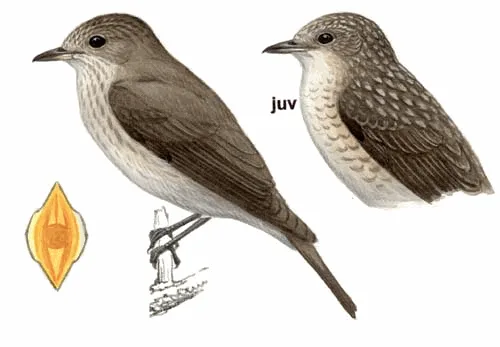 Spotted Flycatcher Spotted Flycatcher (Muscicapa striata) [order] PASSERIFORMES | [family] Muscicapidae | [latin] Muscicapa striata | [UK] Spotted Flycatcher | [FR] Gobe-mouches gris | [DE] Grauschnapper | [ES] Papamoscas Gris | [NL] Grauwe Vliegenvanger Subspecies
Physical charateristicsSpotted Flycatchers lack any striking features. They are grey-brown in colour with an off-white breast, streaked with darker grey and a streaked forehead. Young birds are very spotted with pale brown on the back and head. Spotted Flycatchers have a thin, squeaky song and call which is distinctive but not very noticeable. Listen to the sound of Spotted Flycatcher [audio:http://www.aviflevoland.nl/sounddb/S/Spotted Flycatcher.mp3]
RangeEurasia : Central, West HabitatAlmost throughout west Palearctic, from Mediterranean and steppe through temperate and boreal to edge of Arctic zone. Absent, however, from open areas devoid of trees and bushes and from densely forested, arid or exposed mountainous areas, although breeding freely up to 900 m and sporadically to 1500 m. Dependent on availability of raised perches, especially in such deciduous trees as beech, oak, and chestnut, and lesser extent conifers such as pine and larch. Requires ample accessible space for catching flying insects present at adequate density, and accordingly has adapted readily to avenues, parks, gardens, orchards, and other man-made habitats. ReproductionOn natural or artificial ledge, or in niche, requiring firm support below for loosely built nest, good view for incubating bird, and, often, overhang above nest for shelter: on tree-trunk supported by twigs; in creeper or in shallow crevice of tree or wall; on top of flat branch; on top of stacked wood, etc., piled against wall; in old nest of other bird. Spotted Flycatchers will also readily occupy open-fronted nest boxes or other artificial sites. Nest is a loosely built cup of fine twigs, rootlets, dry grass, moss, and lichens, lined with hair, feathers, and fine fibres. One or two clutches of 4-6 (2-7) eggs, some decline in clutch size through season. Incubation period is 12-14 days, tended by female. Young fledge after 12-16 days. Feeding habitsWhen it is colder and the abundance of flying prey is low, they forage high in the tree canopy, hovering by the leaves and moving about in the very top of the trees. On warmer days they feed on flying insects which they catch by pursuit, especially Flies, Aphids, Beetles, Ants, Bees and Wasps. Spotted Flycatchers are rarely seen on the ground but will occasionally hop to pick up food. ConservationThis species has an extremely large range, and hence does not approach the thresholds for Vulnerable under the range size criterion (Extent of Occurrence <20,000 km2 combined with a declining or fluctuating range size, habitat extent/quality, or population size and a small number of locations or severe fragmentation). Despite the fact that the population trend appears to be decreasing, the decline is not believed to be sufficiently rapid to approach the thresholds for Vulnerable under the population trend criterion (>30% decline over ten years or three generations). The population size is extremely large, and hence does not approach the thresholds for Vulnerable under the population size criterion (<10,000 mature individuals with a continuing decline estimated to be >10% in ten years or three generations, or with a specified population structure). For these reasons the species is evaluated as Least Concern.  MigrationLong-distance migrant with all races moving to sub-Saharan Africa, majority wintering south of equator. Many birds are still on passage in central Africa, including areas south of equator, in October-November, spending only December-February in southernmost wintering areas. In spring this is one of the latest migrants to return to northern breeding grounds early June in extreme cases. Autumn recoveries in Europe and North Africa indicate migratory divide at c. 12 degrees E: birds from Britain, Ireland, and western Europe initially head south-west to SSW through western France and Iberia; birds from central Europe and Fenno-Scandia head SSW to south-east through Italy, Greece, and Aegean. Despite migratory divide, passage through Mediterranean, North Africa, and Sahara on broad front (both seasons), and south European birds presumably head more directly south, with little or no division. Autumn departure begins late July, chiefly from August. Movement through Mediterranean region mid-August to mid-November, chiefly September-October. Reaches East Africa October-November, and South Africa late October to December. Passage north starts late February or March. Passage through North Africa and Mediterranean region chiefly from mid-April, continuing to end of May. First arrivals in northern Europe in mid- or late April, but mainly in May, continuing to end of June. Distribution map |
]]>
